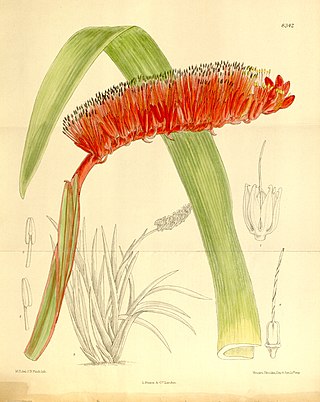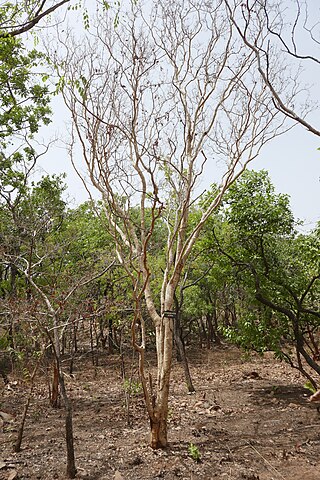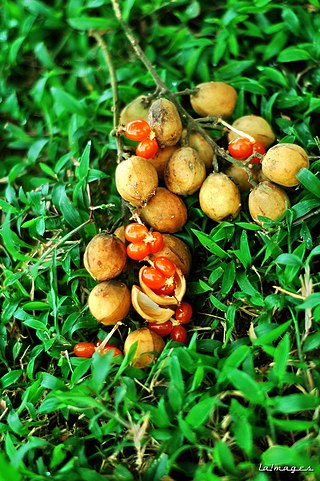
Xeronema is a genus of flowering plants containing two species, Xeronema moorei from New Caledonia, and Xeronema callistemon from the Poor Knights Islands and Taranga Island in New Zealand. The plants are herbaceous monocots, spreading by rhizomes, and have large flowers set on terminal spikes, with stamens towering above the flowers.

Antidesma is a genus of tropical plant in the family Phyllanthaceae formally described by Linnaeus in 1753. It is native to tropical Africa, S + E + SE Asia, Australia, and various oceanic islands. The greatest diversity occurs in Southeast Asia.

Phyllanthaceae is a family of flowering plants in the eudicot order Malpighiales. It is most closely related to the family Picrodendraceae.

Leptopus, the maidenbushes, are a genus of plants in the family Phyllanthaceae native to southern Asia from the Caucasus east to China and Maluku. The plants are monoecious herbs and shrubs with simple, entire leaves and small, green flowers.

Bischofia is a genus of plants in the family Phyllanthaceae first described as a genus in 1827. It is native to southern China, the Indian Subcontinent, Queensland, New Guinea, and various islands of the Pacific. It is the only member of the tribe Bischofieae. They are dioecious, with male and female flowers on separate plants, but may rarely be monoecious.
Leptonema is a genus of flowering plant belonging to the family Phyllanthaceae first described in 1824. The entire genus is endemic to Madagascar. It is dioecious, with male and female flowers on separate plants.
- Leptonema glabrum(Leandri) Leandri
- Leptonema venosum(Poir.) A.Juss.

Aporosa is a genus of flowering plant belonging to the family Phyllanthaceae, first described as a genus in 1825. It is native to China, the Indian Subcontinent, Southeast Asia, Papuasia, and Queensland.
Ashtonia is a genus of flowering plant belonging to the family Phyllanthaceae first described as a genus in 1968. It is native to the Malay Peninsula and Borneo. It is dioecious, with male and female flowers on separate plants.
- Ashtonia excelsa Airy Shaw - Borneo
- Ashtonia praeterita Airy Shaw - S Thailand, W Malaysia

Baccaurea is a genus of flowering plant belonging to the family Phyllanthaceae. The genus comprises over 100 species, distributed from Malesia to the West Pacific. It is dioecious, with male and female flowers on separate plants. Many species contain edible fruits.
Protomegabaria is a genus of flowering plant belonging to the family Phyllanthaceae first described as a genus in 1911. It is native to western and central Africa. It is dioecious, with male and female flowers on separate plants.
- Protomegabaria macrophylla(Pax) Hutch. - Nigeria, Cameroon, Republic of the Congo, Gabon, Gulf of Guinea Islands
- Protomegabaria meiocarpaJ.Léonard - Gabon, Democratic Republic of the Congo
- Protomegabaria stapfiana(Beille) Hutch. - West Africa

Richeria is a genus of flowering plant belonging to the family Phyllanthaceae first described as a genus in 1797. It is native to Central America, South America, and the West Indies. Richeria is dioecious, with male and female flowers on separate plants.
- Richeria australis - São Paulo, Mato Grosso
- Richeria dressleri - Costa Rica, Nicaragua, Panama, Ecuador
- Richeria grandis - Panama, N South America, E West Indies
- Richeria obovata - Costa Rica to Bolivia
- Richeria tomentosa - Colombia, Ecuador

Hymenocardia is a genus of trees in the family Phyllanthaceae first described as a genus in 1836. Most of the species are native to Africa, with one in Southeast Asia.

Breynia is a plant genus in the family Phyllanthaceae, first described in 1776. It is native to Southeast Asia, China, the Indian Subcontinent, Papuasia, Australia, and the island of Réunion.

Asteliaceae is a family of flowering plants, placed in the order Asparagales of the monocots.
Baccaurea odoratissima is a species of plant in the family Phyllanthaceae. It is endemic to the Philippines.

Baccaurea polyneura is a species of plant in the family Phyllanthaceae. It is native to Peninsular Malaysia, and Sumatra island of Indonesia. The fruit, called jentik, is edible, if sour, and is locally harvested and sold.

Baccaurea motleyana is a species of fruit and fruit tree which grows wild in parts of Southeast Asia and is cultivated for its fruit in Bangladesh, Indonesia, Thailand and Peninsular Malaysia. Its common names include rambai and rambi, and in Thai language mafai-farang. In the Bengali language the fruit is known as bugi as local language in Narsingdi like lotka, lotkon or bugi in Bengali locally (লটকা/লটকন/বুগি), in the Assamese language it is known as leteku (লেটেকু). This is a tree generally growing to 9 to 12 meters in height with a short trunk and a broad crown. The evergreen leaves are shiny green on the upper surface and greenish-brown and hairy underneath. Each leaf is up to 33 centimeters (13 in) long and 15 centimeters (5.9 in) wide. The species is dioecious, with male and female flowers growing on separate individuals. Both types of flowers are fragrant and have yellow sepals. The staminate racemes are up to 15 centimeters (5.9 in) long and the pistillate inflorescences may reach 75 centimeters (30 in) in length. The fruits are each 2 to 5 centimeters long and about two wide and grow in strands. Each fruit has velvety pinkish, yellow, or brown skin which wrinkles at ripening and is filled with whitish pulp containing 3 to 5 seeds. The pulp is sweet to acid in taste. They may be eaten raw or cooked or made into jam or wine. The tree is also used for shade and low-quality wood.

Breynia disticha is a plant in the family Phyllanthaceae, first described in 1776. It is native to New Caledonia and Vanuatu in the western Pacific, but naturalized on a wide assortment of other islands around the world, as well as in the U.S. state of Florida.

Baccaurea lanceolata is a species of plant in the family Phyllanthaceae. It is found in Malaysia, Indonesia and Thailand. It grows in lowland rainforest, at an altitude between sea level and 1,300 metres (4,300 ft).

Baccaurea courtallensis is a species of flowering plant belonging to the family Phyllanthaceae. It is endemic to the Western Ghats mountains in India. It is a medium size evergreen understory tree frequent in tropical wet evergreen forests of the low and mid-elevations (40-1000m). It is a Near Threatened species according to the IUCN Red List of Threatened Species.














